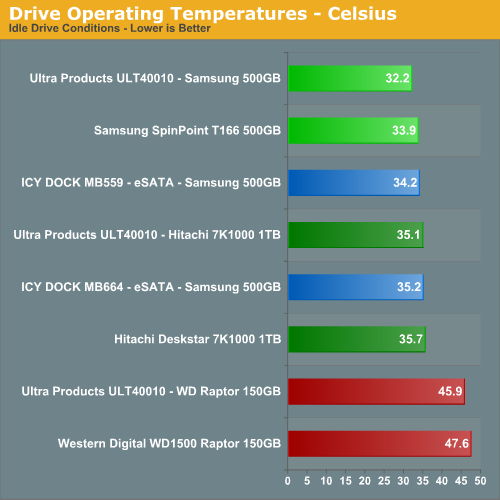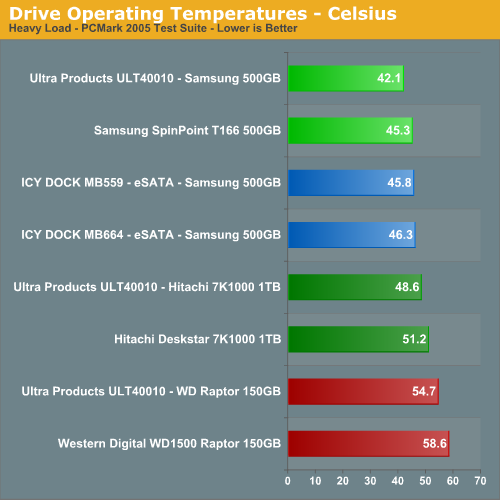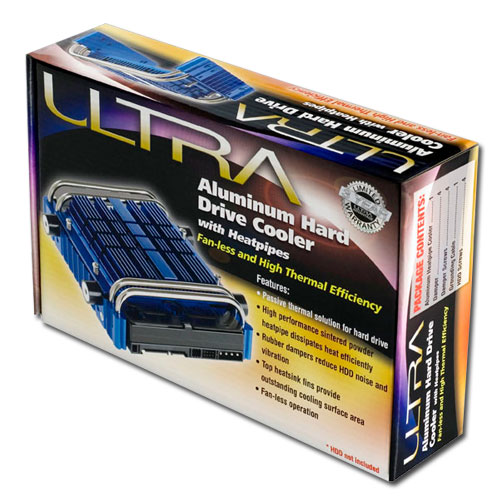Test Results


Clearly, the Ultra Products ULT40010 provides superior heat dissipation compared to a bare drive in a standard 3.5" HD case mount. Our Samsung drive, already having earned its reputation as one of the coolest hard drives to grace our test labs, not only runs almost two degrees cooler when mounted using the ULT40010, but it also takes longer to reach this peak temperature. Out of curiosity, we worked the hard drive out in a long (30GB) archive process to see if we could make the heat climb any further, and were only successful in reaching a maximum threshold of one degree higher (43C). The additional surface area of the Ultra cooler (with its cooling fins and heat pipes) allows sufficient thermal transfer to make a noticeable difference, even in our relatively cool-running Samsung drive.
The results were even better with our Hitachi 7K1000 and Western Digital Raptor drives. Idle temperatures on the Hitachi drive only dropped about 1%, but load temperatures dropped over 5% in our test system. The 150GB Raptor has the highest idle and operating temperatures of any hard drive in our labs. As such, this is the drive that would tell us just how well the ULT40010 is designed as a passive cooling unit. We were not disappointed as idle temps dropped 3% and load temperatures decreased over 7%. Once again we ran our 30GB archive test and temperatures did not vary more than 1% over the course of several archive sessions.
Conclusion

Ultra also advertises that the cooler will reduce noise compared to a standard test setup, but we were unable to discern any difference in our test bed. Presumably, Ultra's claim refers to the rubber mount contacts that reduce case vibration compared to cheaper PC cases that use steel-only hard drive housings. While this claim is certainly true, there has been a trend in the midrange to high-end PC cases to have some type of rubber or foam in place wherever storage devices will contact the case chassis. Given the MSRP of $43 for the ULT40010, it stands to reason that anyone looking at this cooler as an option already has a good quality case with vibration dampening hardware inside. While this does potentially remove one of the items in Ultra's favor, it doesn't take away from the fact that the ULT40010 performs well as a passive hard drive cooler, which is its primary selling point.
The Ultra cooler does what it says, but it doesn't perform miracles. Good active cooling solutions tend to perform better than good passive cooling solutions. While this cooler is indeed an example of a very good passive cooling solution, it does mean that it has somewhat less impact than it likely could if it had (for example) a fan mounted on the top. The trade-off, however, is well worth it to users looking for a case that runs as close to silently as possible. For that reason, Ultra Product's ULT40010 hard drive cooler is an excellent choice for HTPC users, and anyone seeking to help mitigate a hard drive heat problem without adding additional noise to their PC configuration.


Clearly, the Ultra Products ULT40010 provides superior heat dissipation compared to a bare drive in a standard 3.5" HD case mount. Our Samsung drive, already having earned its reputation as one of the coolest hard drives to grace our test labs, not only runs almost two degrees cooler when mounted using the ULT40010, but it also takes longer to reach this peak temperature. Out of curiosity, we worked the hard drive out in a long (30GB) archive process to see if we could make the heat climb any further, and were only successful in reaching a maximum threshold of one degree higher (43C). The additional surface area of the Ultra cooler (with its cooling fins and heat pipes) allows sufficient thermal transfer to make a noticeable difference, even in our relatively cool-running Samsung drive.
The results were even better with our Hitachi 7K1000 and Western Digital Raptor drives. Idle temperatures on the Hitachi drive only dropped about 1%, but load temperatures dropped over 5% in our test system. The 150GB Raptor has the highest idle and operating temperatures of any hard drive in our labs. As such, this is the drive that would tell us just how well the ULT40010 is designed as a passive cooling unit. We were not disappointed as idle temps dropped 3% and load temperatures decreased over 7%. Once again we ran our 30GB archive test and temperatures did not vary more than 1% over the course of several archive sessions.
Conclusion

Ultra also advertises that the cooler will reduce noise compared to a standard test setup, but we were unable to discern any difference in our test bed. Presumably, Ultra's claim refers to the rubber mount contacts that reduce case vibration compared to cheaper PC cases that use steel-only hard drive housings. While this claim is certainly true, there has been a trend in the midrange to high-end PC cases to have some type of rubber or foam in place wherever storage devices will contact the case chassis. Given the MSRP of $43 for the ULT40010, it stands to reason that anyone looking at this cooler as an option already has a good quality case with vibration dampening hardware inside. While this does potentially remove one of the items in Ultra's favor, it doesn't take away from the fact that the ULT40010 performs well as a passive hard drive cooler, which is its primary selling point.
The Ultra cooler does what it says, but it doesn't perform miracles. Good active cooling solutions tend to perform better than good passive cooling solutions. While this cooler is indeed an example of a very good passive cooling solution, it does mean that it has somewhat less impact than it likely could if it had (for example) a fan mounted on the top. The trade-off, however, is well worth it to users looking for a case that runs as close to silently as possible. For that reason, Ultra Product's ULT40010 hard drive cooler is an excellent choice for HTPC users, and anyone seeking to help mitigate a hard drive heat problem without adding additional noise to their PC configuration.










31 Comments
View All Comments
PandaBear - Friday, November 2, 2007 - link
Agree. HD are ususally designed to sustain 60C (at least the one they sell to OEM like DELL need to meet spec at this temp), so 35C is not much of a problem. What you need to do is either test it in a cramped setup (stacked drive or small case with no/low ventilation) or high performance high temperature mission critical drive (at least a raptor if not a 10k rpm scsi). In other word, server.But in either case, the room this cooler takes is not worthed the marginal cooling performance.
mindless1 - Sunday, November 4, 2007 - link
The problem is that the data is useless without knowing two more things:1) Whether the manufacturer spec'd temp means the Smart Reported temp.
2) What temp the other components are and whether their difference in temp is factored for in the smart temp rating if #1 is true.
To put it another way, you cannot use smart to determine if this 'sink has an equal effect on all portions of a hard drive, particularly parts on the PCB instead of those effectively 'sunk by the drive frame, and further, we'd have to know if the temp sensor was even 'sunk to the drive frame since that is what this product is cooling most directly, or rather if the temp sensor is integral to another IC or a discrete sensor on the PCB.
Suppose one scenario where the sensor is in an IC, the drive eventually fails from bearing wear. This cooler "might" have then had an impact on drive lifespan, depending on how/why the bearing failed.
Suppose another scenario where the motor controller (or in some cases, driven power members not the controller IC itself) was heat stressed and failed. Being not so far from the drive frame might result in less radiated heat with this 'sink cooling the frame, but in a typical case with passive intake around a HDD bay, the 'sink will also change the airflow pattern past the drive which could instead cause that motor controller to run hotter (or cooler, we don't know and it could depend on the particular case the combo was installed into whether this was any better or worse than having no 'sink at all and just taking the 5-1/2" bay faceplate off to increase (intake) airflow through the bay.
customcoms - Friday, November 2, 2007 - link
Everything else in my pc has heatpipes, why not my hd? <sarcasm>strikeback03 - Friday, November 2, 2007 - link
Is that the Samsung HD501LJ in the photo on page 2 of a hard drive in the cooler? I have one of these hard drives sitting next to me waiting to be boxed up for RMA, and it does not have the 4-pin Molex connector that the drive in the photo has.Also, are those heat pipes doing much? They don't have fins attached, so they would seem to be just transferring heat between 2 equally warm locations on either side of the cooler, while dumping a little from their own surface area.
Dave Robinet - Friday, November 2, 2007 - link
No - that's a stock photo that we used for illustration purposes only.The heat pipes will undoubtedly be offering some benefit, yes (there are heatpipe-only coolers out there for hard drives, for example). It's not really possible to measure just how much of the overall benefit they're giving, though, without actually modifying the cooler to remove the heat pipes from the equation.
Bozo Galora - Friday, November 2, 2007 - link
thats real nice, except, as it turns out, there is no correlation between HDD heat and failure rates - DUH!http://209.85.163.132/papers/disk_failures.pdf">http://209.85.163.132/papers/disk_failures.pdf
so - BURN BABY BURN!!!
mindless1 - Sunday, November 4, 2007 - link
As it turns out, the paper does not support that there is no correlation between HDD heat and failure rates because all drives weren't ran dead and drives weren't subjected to very excessive temps. On the contrary there was an expectation ahead of time that the drives would work as installed - remembering they were actually using them. What that study instead shows is that until temps reach certain threshold levels, other failure factors are more significant. In other words, it's not a contest to get your hard drive as cool as possible, only keep it cool enough.As someone who has owned drives that would logically lock up from overheating if just left sitting upside down on a desk, vs running fine continually in a case with good ventilation, I'm quite sure of the effect of temp, it is a clear reproducible effect on some drives, probably all drives but a matter of how hot they're actually getting.
That doesn't justify this contraption though, a good passive intake will suffice in all but extreme conditions where it'd require a fan to achieve an acceptible result.
Calin - Friday, November 2, 2007 - link
I think you should have tested with a drive known as hot, not one known as cool. I haven't seen one, but maybe a Raptor would be a better test platform. Especially if you take price into consideration. Who in their right minds would buy a $43 cooling device for a $100+ hard drive known as running cool?On the other side, someone who bought a $180, 150GB Raptor drive might just as well buy a nice cooling system for it.
Dave Robinet - Friday, November 2, 2007 - link
We chose one of the quietest drives to test, as that's the most likely candidate for a HTPC system. Raptors are relatively noisy little beasties, and are less likely to find themselves sitting in living rooms.I'd say it's a reasonable statement that in general, active cooling is better than passive cooling (considering the same quality, etc). With that in mind, if you've already got a fiery-hot-and-very-loud Raptor in your system, you may be better served for your $43 by buying an active cooling solution. :)
Point taken, however. I'll see if I can get some Raptor test data up in the next couple of days.
Thanks for reading!
Calin - Friday, November 2, 2007 - link
Nice article overall.However, in an HTPC (depending on your case choice) you might or might not have an extra 5.25" bay where to put the hard drive.